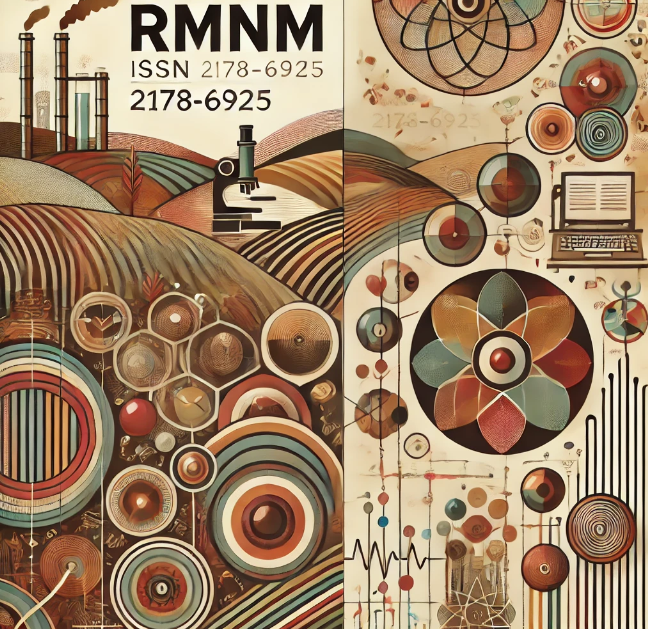METHODOLOGIES/STRATEGIES OF MATHS TEACHING FOR DEAF STUDENTS OF ELEMENTARY SCHOOL II
DOI:
https://doi.org/10.61164/rmnm.v7i1.2714Keywords:
: Education of the deaf; Methodologies/Strategies for teaching mathematics; Elementary School II; Teaching mathematics to the deaf.Abstract
Given the educational and social scenario that the deaf community has been facing over the course of a century, this paper conducts a bibliographical research with the objective of surveying and analyzing the methodologies/strategies that are being used in teaching Mathematics to deaf students in Elementary School II, as well as investigating some active strategies and methodologies, exposing possible alternatives to make the education of these students more meaningful, together with the importance of using the visuospatial space. The objectives emerged in order to seek the answer to the research problem, which is: what are the methodologies/strategies that are being used in teaching Mathematics to deaf students in Elementary School II? This paper also presents a brief retrospective on deafness and the education of the deaf, providing readers with a greater familiarity with the subject and the struggle that this community has been facing over so many years. The research was conducted in the CAPES journals database, considering only academic productions prepared in article format, from 2013 to 2023, with the aim of achieving the proposed objectives. The results of the research also served as a warning, since among 31 articles found, only 2 of them met the objectives set. At the end, these two articles are analyzed and discussed, highlighting the importance of using methodologies/strategies that differ from traditional teaching in the education of these students.
References
AZEVEDO, G. T. de; MALTEMPI, M. V. Processo de Aprendizagem Matemática à luz das Metodologias Ativas e do Pensamento Computacional. Ciência & Educação, Bauru, v. 26, e20061, 2020. Disponível em: https://doi.org/10.1590/1516-731320200061. Acesso em 23 de agosto de 2022.
BERBEL, N. A. N. As metodologias ativas e a promoção da autonomia de estudantes. Ciências Sociais e Humanas, Londrina, v. 32, n. 1, p. 25-40, jan./jun. 2011.
BÖHM, F. C.; GRUTZMANN, T. P; LEBEDEFF, T. B. O Ensino de multiplicação e a teoria dos campos conceituais: uma prática com alunos surdos. In: Revista Educar Mais, vol.7, 2023. p.427-443. Disponível em: https://periodicos.ifsul.edu.br/index.php/educarmais/article/view/3147. Acesso em: 14 de abril de 2023.
BRASIL. Lei n.º 9.394, de 20 de dezembro de 1996. Estabelece as diretrizes e Bases da Educação Nacional. Disponível em: http://www.planalto.gov.br/CCIVIL_03/leis/L9394.htm. Acesso em: 20 de agosto de 2022.
BRASIL. Lei nº 14.191. de 3 de agosto de 2021. Disponível em: https://www.in.gov.br/en/web/dou/-/lei-n-14.191-de-3-de-agosto-de-2021-336083749. Acesso em: 14 de junho de 2023.
DOS SANTOS, J. R. S. Lugar de fala. In: LONGO, A. C. F. (Orgs). Uma reflexão de direitos humanos. Brasília: CEUB, 2022. p. 22-25.
GIL, A. C. Como elaborar projetos de pesquisa. 5.ed. – São Paulo: Atlas, 2010.
GOLDFELD, M. A criança surda: linguagem e cognição numa perspectiva sócio-interacionista. 2. ed. São Paulo: Plexus, 2002.
LIMA, N. M. F. de. Inclusão escolar de surdos: entre o dito e o feito. In. LODI, A. C. B.; MÉLO, A. D. B; FERNANDES, E. (Orgs.). Letramento, bilinguismo e educação de surdos. 2 ed. Porto Alegre: Mediação, 2015. p.303-332.
MARCONI, M. de A.; LAKATOS, E. M. Fundamentos de metodologia científica. 7 ed. - São Paulo: Atlas, 2010.
MATTOS, G. C. Políticas nacionais de inclusão educacional com ênfase na in(ex)clusão do surdo na escola regular. Revista Educação Inclusiva, v. 8, n. 1, p. 102-116, 2023. Disponível em: https://revista.uepb.edu.br/REIN/article/view/1853/1481. Acesso em: 15 de maio de 2023.
PADILHA, A.L. Desafio para a formação de professores: alunos surdos e ouvintes na mesma sala de aula? In: LODI, A.C. B; LACERDA, C.B.F.de. (Orgs.). Uma escola, duas línguas: letramento em língua portuguesa e língua de sinais nas etapas iniciais de escolarização. Porto Alegre: Mediação, 2009. p.113-126.
SÁ, N. R.L. de. Cultura, poder e educação de surdos. São Paulo: Paulinas, 2006.
SANTANA, A. P. Surdez e linguagem: aspectos e implicações neurolinguísticas. São Paulo: Plexus, 2007. p. 21-52.
SANTOS, K. R. de O. R. P. Projetos educacionais para alunos surdos. In. LODI, Ana C. B.; MÉLO, A. D. B; FERNANDES, E. (Orgs.). Letramento, bilinguismo e educação de surdos. 2 ed. Porto Alegre: Mediação, 2015. p.71-87.
SKLIAR, C. Os Estudos Surdos em Educação: problematizando a normalidade. In. SKLIAR, C. (Org.). A surdez. Um olhar sobre a diferença. 6. ed. Porto Alegre: Mediação, 2013. p. 7-32.
SOUSA, M. J. F. de. Jogo Ladeira Matemática: uma possibilidade de ferramenta para a inclusão de estudantes surdos no estudo das operações básicas. In: Boletim Cearense de Educação e História da Matemática, 2021, Vol.8 (23), p.1284-1300. Disponível em: https://revistas.uece.br/index.php/BOCEHM/article/view/5151. Acesso em: 07 de abril de 2023.
ZALUSKI, F. C.; OLIVEIRA, T. D. de. Metodologias ativas: uma reflexão teórica sobre o processo de ensino e aprendizagem. In: CONGRESSO INTERNACIONAL DE EDUCAÇÃO E TECNOLOGIAS, 2018, Rio Grande do Sul. Educação e Tecnologias: Aprendizagem e construção do conhecimento. Anais do CIET: EnPED, São Carlos:
Downloads
Published
How to Cite
Issue
Section
License
Copyright (c) 2024 Revista Multidisciplinar do Nordeste Mineiro

This work is licensed under a Creative Commons Attribution-NonCommercial-ShareAlike 4.0 International License.




